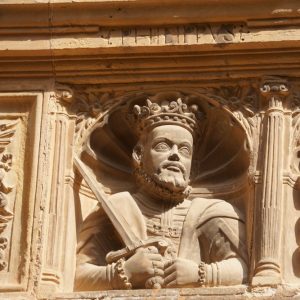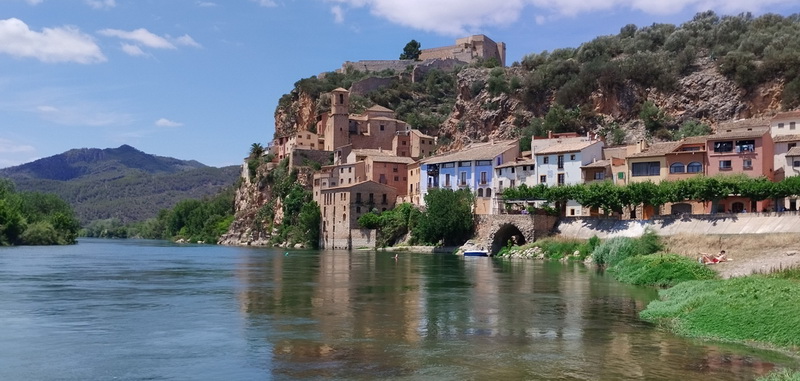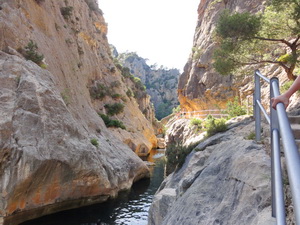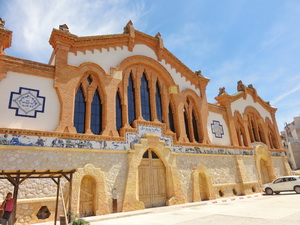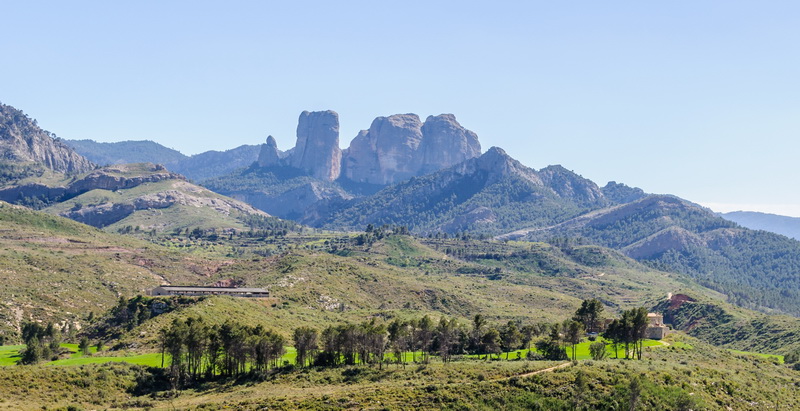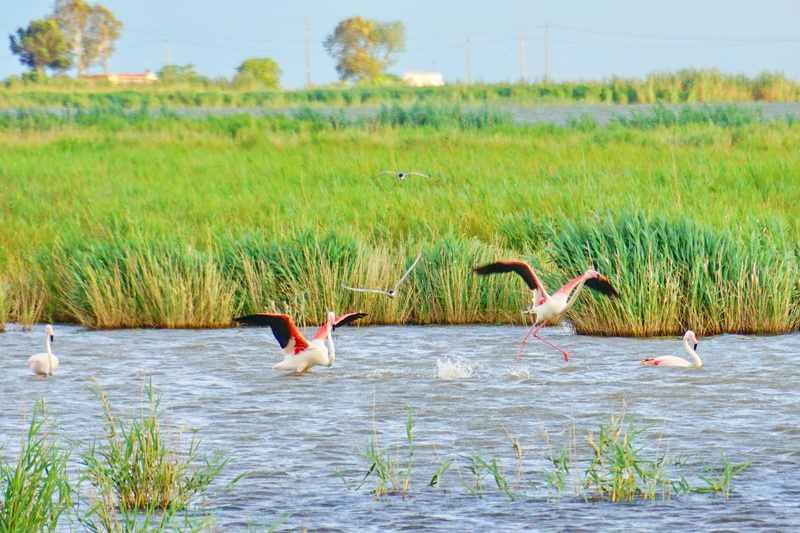
Everything you need to know for 2 or 3 days in the Ebro Delta
There are so many things to see and do in the Ebro Delta and nearby that we usually recommend at least 3 nights in the area whether visiting on a short break or as as part of a broader tour of Catalonia . Here’s our guide covering all the Ebro Delta highlights…
The Ebro Delta (Delta de l’Ebre)
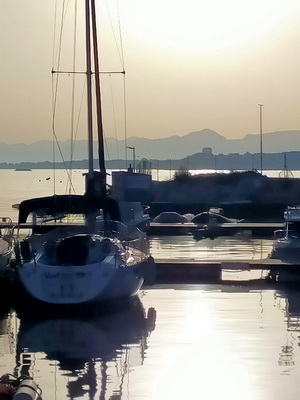
Rice has been grown here for centuries, and the vast rice fields create a beautiful patchwork across the delta. Paired with the freshest seafood straight from the sea – you can sail out and sample oysters and mussels direct from the platforms where they grow – the local rice dishes, like ‘arroz a banda’, are not to be missed, accompanied by a glass of local cava perhaps!
In addition to its natural beauty, the Delta del Ebro has a rich history, with ancient settlements and fishing traditions still very much alive. You can explore the local towns or head out on the water, sailing in the protected bay.
The climate here is warm throughout the year, with hot summers and mild winters, making it a great destination particularly in the spring and autumn months. Whether you’re looking to explore the region’s ecology, taste its seafood, or simply enjoy the quiet beauty of the landscape, the Delta del Ebro offers a relaxing, nature-filled escape.
Terres de l’Ebre
Little-known Tortosa is a fascinating town with a rich history, thanks to its strategic position near the mouth of the Ebro River in a narrow mountain pass. A crossroads of cultures; Romans, Moors, and Christians, all have left their mark and the town’s impressive cathedral and the Suda Castle offer a fascinating glimpse into its past.
The surrounding landscape is equally impressive the Els Ports Nature Park, with mountains rising from the Mediterranean coast up to 1500m offers fantastic hiking routes, wildlife, and incredible views over the whole region.
Head upriver to the Terra Alta wine region famous for its modernist ‘Cathedrals of Wine’ and Horta de Sant Joan where a young Picasso convalesced and practiced his art – but be sure not miss picture-perfect Miravet, famous for its imposing Templar Castle, perched high above the Ebro – the views from the top, and from the riverbank, are truly breathtaking.
Table of Contents
Delta de Ebro Highlights – 12 things to see and do in Delta and nearby
- Birdwatching in the Delta
- Tortosa
- Sailing and Seafood in San Carlos
- Marvellous Miravet
- San Joan de la Horta – Picasso’s retreat
- Terra Alta Cycleway
- Cathedrals of Wine
- Spanish Civil War – Battle of the Ebro
- Mas del Director
- Els Ports National Park
- Museu de les Terres de L’Ebre
- Moleta del Remei – Iberian settlement
Practicalities – Frequently asked questions about things to see and do in the Ebro Delta and Terres de l’Ebre
Delta de Ebro Highlights
Birdwatching in the Delta
Flamingos, and so much more, among the rice fields
Even if you’re not an ardent birdwatcher the spectacular birdlife of the Ebro Delta is sure to surprise and delight.
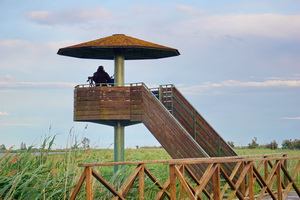
Laguna de la Encanyssada and Laguna de la Tancada and the Punta de Banya are ideal spots to watch the flamingos and other waterfowl. The best place to begin is possibly the Reserva Natural Riet Vell – Centre de Visitants, run by SEO / Birdlife (the oldest conservation organization in Spain). They have two bird observatories positioned to get the best possible birdwatching.
Reserva Natural Riet Vell – Visitor center: Wednesday to Fri from 09:00 to 14:00; Sat from 10:00 to 14:00 / 16:00 to 18:00; Sun from 10:00 to 14:00; Mon and Tues closed.
Tortosa
A little known gem with a rich Moorish & Medieval past
An immensely strategic position on the Ebro River, Tortosa has been inhabited since prehistoric times, the city was established by the Romans as ‘Derdosa’, later becoming Moorish ‘Turtusha’, before being conquered by the Knights Templar and receiving its current name of Tortosa – a rich history indeed!
At the gateway, where the mountains close in, between the Ebro Delta and the interior, the reason for its historic importance is easy to see. Add to this the erstwhile importance of the Ebro River itself, as the border between Rome and Carthage and later as a major trading port and thoroughfare for goods from across the Mediterranean and even the Americas, and we start to understand the prestige and wealth that Tortosa once enjoyed.
Sant Carles de la Rápita
Seafood & Sailing on the Delta
Believed to have been inhabited since 22,000BC La Rápita was established as a town under Moorish, becoming Sant Carles after the Christian reconquest. The 18th century saw major development of the port and navigation channels laying the foundations for what is now the biggest fishing port on Spanish Mediterranean.
Though not traditionally pretty Sant Carles has a couple of nice, sheltered beaches and is an active fishing port with plenty going on – and, of course, it’s a wonderful place to eat fish and seafood!
Head down to the Nautical Station for all kinds of watersports and take a trip on a fishing boat or out around the bay for a unique view of the Delta (with the opportunity, at Musclarium, to sample oysters and mussels direct from the platforms where they grow!
Butterfly Sailing Boat
Beautiful sailing boat harboured in Sant Carles. Visit the mussel farms and get a unique view of the Delta.
+34 660 907 189
Butterfly Charters
Musclarium – farm-fresh seafood
Enjoy mussels and oysters direct on the growing platform – with a glass off local cava. Water taxis available from Sant Carles
+34 638283986
Musclarium info
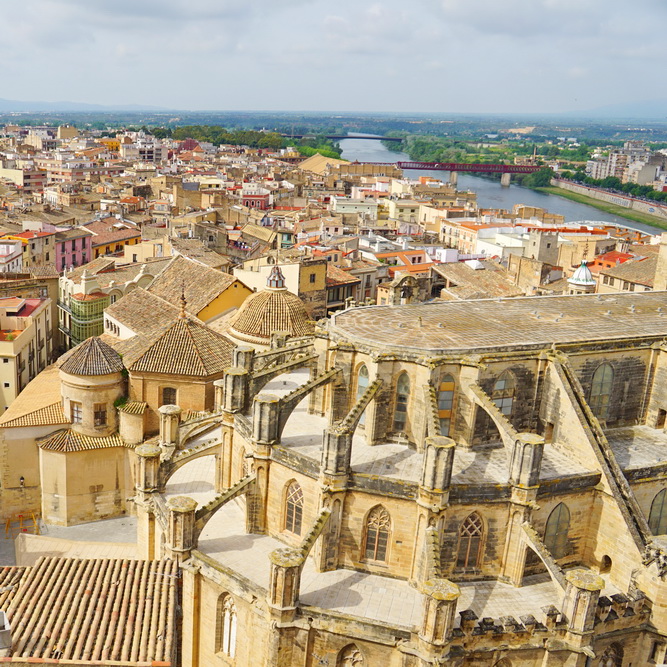
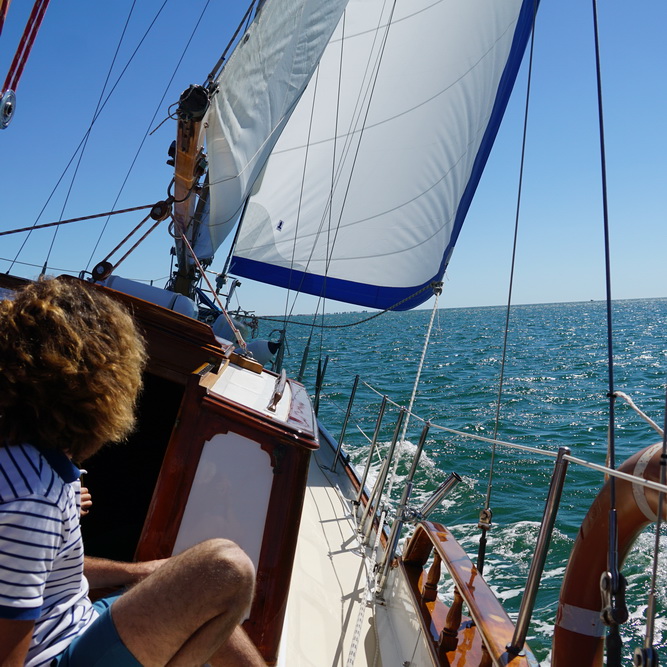
Miravet
Stunning views from every angle!
Up-river from Tortosa the delightful medieval town of Miravet was likewise highly strategic, due to its position on the Ebro and on the border of the Moorish territory. The Templar castle was originally built by the Moors then converted into a fortified monastery after its conquest in 1153. The views from the castle over the town and river are wonderful – as are the views from the river to the castle – Miravet is a beauty from any angle!
The town is renowned for its pottery and if you’re feeling energetic or just want to soak in those views river kayaking is available. Down by the river there are several eateries offering surprisingly good value considering the amazing views they enjoy.
San Joan de Horta
In the footsteps of Picasso
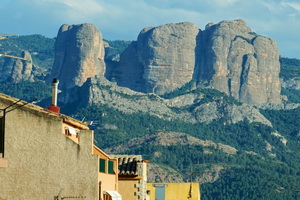
Set behind the Els Ports there are some wonderful swimming spots nearby at Las Ollas, Toll Blau and Azud de Lledo and amazing rock formations at Rocas de Benet, Salt de Ferraso and many more in the mountains surrounding the village.
In the town itself the Ecomuseo dels Ports is an ethnographic museum and a small Picasso Museum.
Cycleway Val de Zafan – Via Verda de la Terra Alta
Following the disused Val de Zafan railway line the Via Verde Val de Zafan runs all the way from Tortosa into the province of Teruel. The stretch which runs through the Terra Alta is particularly attractive with plenty to see and do along the way…
Bike rental is available in the pretty village of Horta de Sant Joan (see below) where you can visit the Ecomuseum of the Ports and the Picasso Center and (maybe at the end) enjoy a swim in the stunning beauty spot “Racó de les Olles” just nearby.
The Terra Alta stretch runs from the Aragonese border (2.5km west) to the station of Pinell de Brai, 20km east (23km each way if you do it all). Head west to the border to begin with for views of the valley and rock formations at Rocas de Benet.
From Horta heading east you’ll enjoy a series of tunnels and aqueducts to Bot station, where there’s a cute café in a converted train wagon, and on to the Santuary of Fontacalda where there’s an amazing bathing spot with hot springs – don’t forget your cozzie! For the energetic you can carry on to the station of Pinell de Brai and a further 6km by road to the Modernista Catedral de Vi de Pinell de Brai – perhaps the finest of all the Modernist wineries in Catalonia (though you can always pop back here by car after dropping the bikes).
Bicisports Aubanell – Bike Rental
Can supply bikes in Horta de Sant Joan or other key spots.
+34 660 53 23 46
[email protected]
Bicisports Aubanell
Viorigen – Combined bike rental / wine tourism
High level of expertise in Terra Alta Garnacha wines – guided routes with tastings
+34 650187401
Viorigen
Cathedrals of Wine
Catalan Moderniste architecture – and wonderful wine…
Thanks to the work of the ‘Moderniste’ architect César Martinell there are a whole string of ‘Wine Cathedrals’ to visit across the south of Catalonia, and in Terra Alta you’ll find two of the finest – La Catedral del Vi de Pinell de Brai and Cooperativa Agricola de Gandesa – within 10km of each other.
The Moderniste philosophy was to combine exquisite form with functionality, turning agricultural and industrial buildings, such as these wine cellars, into inspirational, uplifting spaces. From the delightful façades to the parabolic arches of the roof spaces and the use of gravity in the process, no detail has escaped the architect’s fine touch.
For fans the Cooperativa de Falset is another fine example in the Priorat region, not so far away…
Spanish Civil War – Battle of the Ebro
The final battlefield
The last, bloody battle of the Spanish Civil war was fought out in the Ribera del Ebro in the far north of the Terres de l’Ebre region. Pueblo Viejo in Corbera d’Ebre (just north of Gandesa) has been preserved as testimony to the battle and you’ll also find one of a network of Ebro Battle Interpretation Centres in the village.
Mas del Director – Reserva Natural de Sebes
Reserva Natural de Sebes
Situated in Ribera d’Ebre region, specifically in Flix to the north of Terra Alta this protected Natural Park sits among the meanders of the River Ebro.
The arrival point and reception centre for visitors is the Mas del Director, from where you can start your visit to this natural area on foot or by bicycle.
There are wooden walkways which take you into the exuberant woods, reedbeds and marshes by the river and olive groves, hundreds of years old. Camargue horses and storks and other birdlife are the main points of interest and there are birdwatching hides in strategic positions.
Els Ports National Park
Amazing views over Terres de l’Ebre
Forming a natural frontier with Valencia and Aragon Els Ports was declared a National Park in 2001 Mirador del Caragol just below the highest peak Mont Caro – at over 1500m -gives amazing views over the whole Terres de l’Ebre region (approach from Tortosa).
Museu de les Terres de L’Ebre
From prehistory to the present day
Set in an elegant building in Amposta the Museu de les Terres de L’Ebre gives an amazing insight into the natural, archaeological and ethnological history of the Ebro Delta (Delta de l’Ebre), from prehistory to the present day, with over 35.000 exhibits.
Moleta del Remei –
Iberian settlement from 600BC
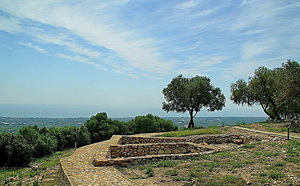
Frequently Asked Questions about Things to See and Do in the Delta de Ebro and Terres de l'Ebre
How to get to the Ebro Delta?
Southern Catalonia is extremely well served with flights from the UK with flights from most UK airports to Reus (Costa Dorada / Tarragona) and Barcelona.
This circular trip can be adapted to suit any of those airports as a start point.
See your options in the table below:
| English airports | Reus connections | Barcelona connections |
| London Gatwick | TUI | Easyjet, Vueling |
| London Stansted | Jet2, Ryanair | Ryanair |
| London Heathrow | B.A., Vueling | |
| London Luton | Easyjet | Easyjet, Ryanair |
| London City | B.A. | |
| London Southend | Ryanair, Easyjet | |
| Manchester | Easyjet, Jet2, TUI, Ryanair | Easyjet, Jet2, Ryanair, Vueling |
| Birmingham | Jet2, TUI, Ryanair | Jet2, Vueling, Ryanair |
| Bristol | Jet2, TUI | Easyjet, Ryanair |
| Newcastle | Jet2, TUI | Ryanair |
| Leeds Bradford | Jet2, Ryanair | Jet2 |
| Liverpool | Ryanair | Easyjet, Ryanair |
| Nottingham | Jet2, Ryanair | |
| Cardiff | TUI | |
| Irish airports | Reus connections | Barcelona connections |
| Dublin | Ryanair | Aerlingus, Ryanair, Vueling |
| Cork | Ryanair, TUI | Ryanair |
| Shannon | Ryanair | |
| Belfast | Jet2, TUI, B.A. (city) | Easyjet |
| Scottish airports | Reus connections | Barcelona connections |
| Glasgow | Jet2, TUI | Easyjet, Ryanair (Prestwick) |
| Edinburgh | Jet2 | Ryanair |
| Aberdeen | TUI |
PLEASE NOTE some flights are seasonal.
When to go to the Ebro Delta?
The Delta de Ebro and southern part of Catalonia is, as may be expected, the warmest part of Catalonia, making ideal for a holiday from March through to late June and again though September and early October when you can witness the wine harvest in Terra Alta and the nearby Priorat region.
The Ebro Delta is perhaps best avoided (by all but the keenest sun worshippers) at the height of summer when the nearby Costa Dorada is also at its busiest.
The Delta de Ebro in particular can be very humid in the summer and mosquitoes can be problematic from mid-July through August. In late October and November the region can be prone to heavy rainfall.
How long to stay in the Ebro Delta?
There’s a lot to see and do in the Ebro Delta and Terres de l’Ebre so we usually suggest three nights. This gives you a chance to relax and explore the Delta itself, take a bike ride on the levies or go sailing and sample the local seafood as well as exploring Tortosa and the hinterland including the mountains of Els Ports and the unique Modernist ‘Cathedrals of Wine’.
What to eat in the Ebro Delta?
Everything!
The Ebro Delta enjoys one of the best locations in the whole of Spain for local gastronomy.
The immense rice fields which cover the Delta produce some of Spain’s finest Paella rice and, of course, there’s a rich culture of rice dishes developed over centuries. Combine with that fresh fish arriving daily to San Carles de la Rápita (Spain’s largest Mediterranean fishing port) and seafood from the Delta and you’ve already got a delicious recipe – but that’s not all!
On top of the local rice and seafood you have produce from the mountains of Els Ports and the Terres de l’Ebre – including the unknown, but unfailingly good, garnacha wines of Terra Alta – all in all an amazing wealth of local produce!
What to buy in the Ebro Delta?
Rice from the local producers is a favourite take-home for Spanish visitors to the region – so much better than anything you’ll find in the supermarket.
Wine or oil from Terra Alta is also a wonderful souvenir – as long as you can carry it home (tricky perhaps if your flying). If you need something non-liquid the almonds are also delicious.
General text to close


